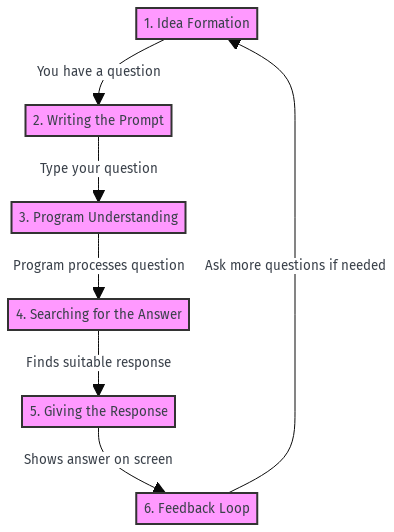Understanding the Lifecycle of a Prompt: From Idea to Use
Hello everyone! Today, we’ll dive into The Journey Of A Prompt. Think of a prompt as a question or command you give to a computer program. It’s like asking your friend a question and waiting for an answer. But how does this question travel from your mind to the screen and then get an answer? Let’s find out!
- Idea Formation:
Everything starts with an idea. Maybe you’re a student trying to solve a math problem, a developer looking to fix a bug, or a business analyst analyzing data. You have a question in your mind, and you need an answer. - Writing the Prompt:
Once you have your idea, you write it down. This is like typing a question into a search engine or giving a command to a software. - Program Understanding:
After you type in your question, the computer program tries to understand what you’re asking. It’s like your friend listening to your question and thinking about the answer. - Searching for the Answer:
The program then looks for the best answer. It checks its knowledge and tries to find the most suitable response. - Giving the Response:
Once the program finds the answer, it shows it to you on the screen. It’s like your friend finally replying to your question. - Feedback Loop:
After getting the answer, you might have more questions or need clarification. So, you can ask again, and the cycle repeats.

Examples
Imagine you're on an online shopping site looking for a blue shirt. You type "blue shirt" into the search bar (that's your prompt). The website tries to understand what you want, searches its product list, and then shows you all the blue shirts available.
You're planning a picnic and need to know if it will rain. You ask a weather app, "Will it rain tomorrow?" The app checks its weather data and tells you the forecast for the next day.
You have some tomatoes and want to make a dish using them. You ask a cooking app, "Recipes with tomatoes." The app understands your need, searches its recipe list, and shows you various dishes you can make with tomatoes.
As a developer, you might face errors in your code. You ask a debugging tool, "Why is this code not working?" The tool checks the code, finds the issue, and suggests a solution.
A business analyst wants to know the sales trend for the past year. They ask their data software, "Show sales trend for 2020." The software analyzes the data and displays the sales graph for that year.
An architect is designing a building and needs to know if the design is safe. They ask their design software, "Check building safety." The software analyzes the design and gives feedback.
You found a great recipe online, but it's in Spanish. You use a translation tool and ask, "Translate this recipe to English." The tool understands the text and provides you with an English version.
You're in the mood for some jazz music. You tell your music app, "Play jazz songs." The app understands your taste, searches its song list, and plays jazz songs for you.
You're feeling unwell and describe your symptoms to a health app. The app checks its knowledge and gives you possible reasons for your discomfort.
A student wants to learn about plants. They ask their learning platform, "Show lessons on plants." The platform searches its lesson list and provides relevant content.
Conclusion
In all these examples, the process remains the same: idea, prompt, understanding, search, response, and feedback. Whether you’re shopping, coding, cooking, or learning, prompts help you communicate with software to get the answers you need. So next time you type a question or command into a program, remember the journey it takes to bring you the answer. And always keep asking, because every question leads to new knowledge!
Pro Tip
Always be clear and specific with your questions. The better you explain what you need, the better the program can help you. Think of it like asking a friend for help – the more they understand your question, the better they can help you. This journey from having a question to getting an answer is a powerful tool in learning, solving problems, and making decisions, no matter if you’re a student, a developer, or a professional from a specific field.
FAQs
-
What is a prompt?
A prompt is like a question or command you give to a computer or software to get an answer or result.
-
How does a prompt start?
It starts with you having a question or needing something from a computer program.
-
Where do I type my prompt?
You can type it into any device like a computer, phone, or tablet that has the program you need.
-
How does the program understand my prompt? The program reads your words and tries to figure out what you’re asking, just like a friend would.
-
What happens after the program understands my prompt?
The program looks for the best answer or solution to your question.
-
How do I get the answer?
The program shows you the answer on your screen.
-
What if the answer is not what I expected?
You can ask more questions or clarify your prompt to get a better answer.
-
Can I use prompts for any kind of question?
Yes, you can use prompts for different things like finding information, solving problems, or getting help with school or work tasks.
-
Is it important how I write my prompt?
Yes, being clear and specific helps the program understand and answer better.
-
Can prompts help me in learning or working?
Absolutely! Prompts can be a great tool for learning new things, solving problems, and making decisions in your studies or work.
